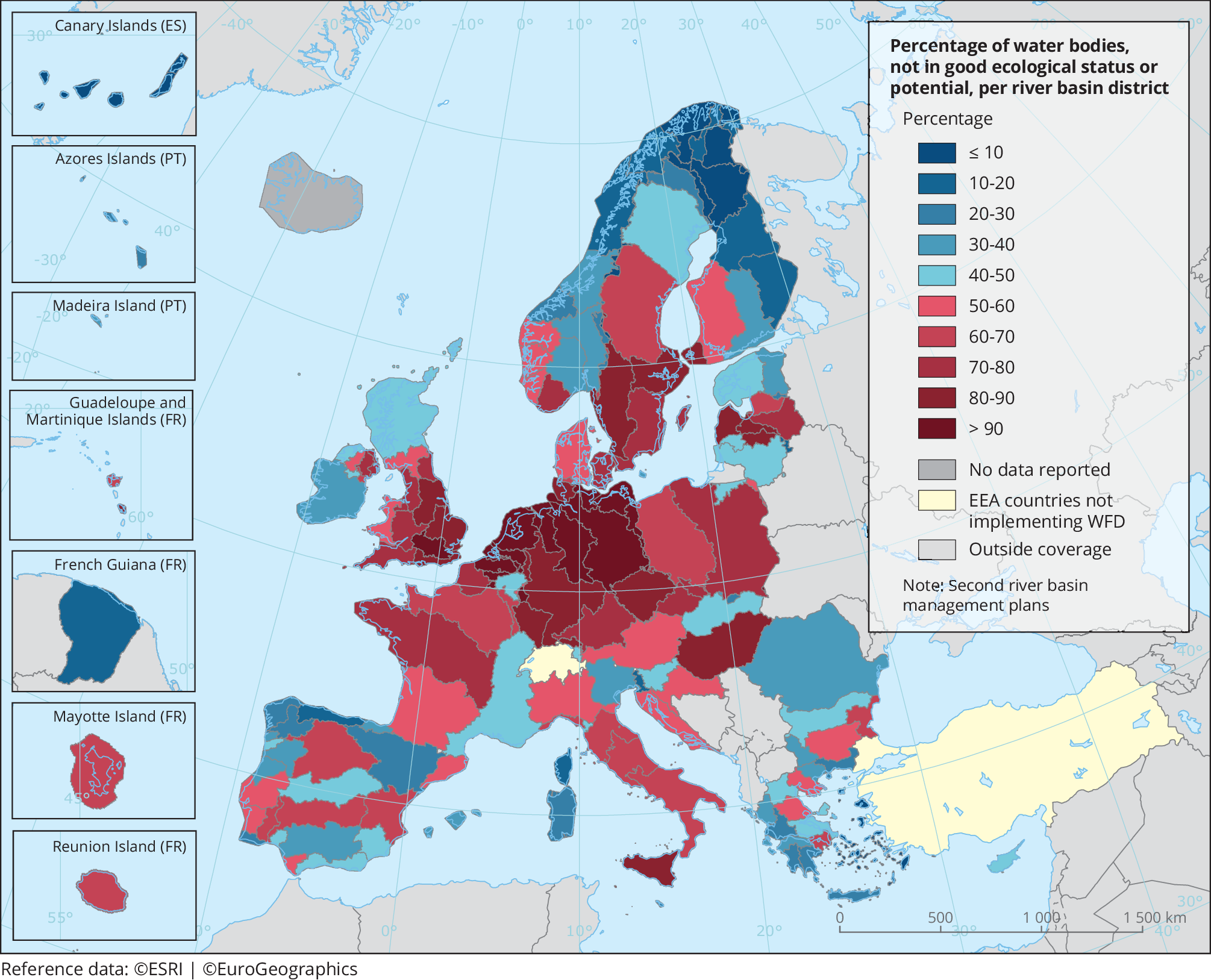All official European Union website addresses are in the europa.eu domain.
See all EU institutions and bodiesThe Water Framework Directive aims to achieve good status for all rivers, lakes and transitional and coastal waters in the EU. Achieving good ecological status for surface waters is critical to this. According to countries’ second river basin management plans, good ecological status had been achieved for around 40% of surface waters (rivers, lakes and transitional and coastal waters) by 2015. However, these plans show only limited improvement in ecological status since the first plans were published in 2009, with ecological status remaining similar for most water bodies.
Figure 1. Distribution of ecological status or potential of classified rivers, lakes, coastal and transitional waters, by count of water bodies
Surface waters are important habitats. They are key for supporting society and the economy throughout Europe and clean, unpolluted waters are essential for healthy ecosystems. However, surface waters have traditionally been used as disposal routes for human, agricultural and industrial wastes, damaging water quality. They have also been altered (by building dams and canals, etc.) to facilitate agriculture and urbanisation, produce energy and protect against flooding, all of which can change and degrade habitats.
The Water Framework Directive (WFD) stipulates that EU Member States should aim to achieve good status for all surface water and groundwater bodies. Ecological status and potential are criteria used to assess the quality of the structure and functioning of surface water ecosystems. Ecological status is influenced by water quality (e.g. pollution) and habitat degradation, and is used as a proxy for the overall status of water bodies.
According to countries’ second river basin management plans (RBMPs) covering the period up to 2015, good or better (high) ecological status has been achieved for only around 40% of surface waters (rivers, lakes, and transitional and coastal waters). Moreover, there has been little improvement in ecological status since the publication of the first RBMPs in 2009, with the status of most water bodies remaining similar. Despite this lack of overall improvement, the status of many of the individual elements that make up ecological status has improved.
The main pressures on surface water bodies are pollution from point (e.g. waste water) and diffuse (e.g. agriculture) sources, and various hydromorphological pressures such as barriers (dams), and low-flow or channelised rivers, with the main impacts being nutrient enrichment, chemical pollution and habitat alterations due to morphological changes.
To improve and restore the approximately 60% of surface waters in the EU that still have less than good ecological status, and meet WFD objectives, full implementation of management and mitigation measures under the WFD, in combination with full implementation of measures under other relevant directives, is needed.
Figure 2. Percentage of water bodies, not in good ecological status or potential, per river basic district

The percentage of water bodies with less than good (i.e. moderate, poor or bad) ecological status varies between river basin districts (RBDs) across Europe. Surface water bodies in north-western Europe have the lowest status. In Belgium (Flanders), northern Germany and the Netherlands, the ecological status of more than 90% of surface waters is reported to be less than good. Other problem areas include Czechia, southern England (United Kingdom), northern France, southern Germany, Hungary and Poland, as well as several individual RBDs in some countries, where 70-90% of surface water bodies are reported to have less than good status.
Northern countries, particularly the northern Scandinavian region, Iceland, Ireland and Scotland (United Kingdom), along with Estonia, Romania, Slovakia and several RBDs in the Mediterranean region, have a high proportion of water bodies with good or better (high) ecological status or potential.
